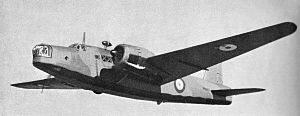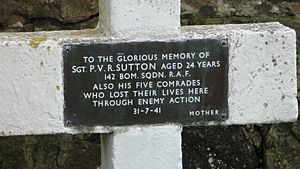No. 142 Squadron RAF facts for kids
Quick facts for kids No. 142 Squadron RAF |
|
|---|---|
 |
|
| Active | 2 Feb 1918 – 1 Feb 1920 1 Jun 1934 – 5 Oct 1944 25 Oct 1944 – 28 Sep 1945 1 Feb 1959 – 1 Apr 1959 22 Jul 1959 – 24 May 1963 |
| Country | |
| Branch | |
| Motto(s) | "Determination" |
| Equipment | B.E.12 Martinsyde Elephant R.E.8 B.E.2 Armstrong-Whitworth F.K.8 Hawker Hart Hawker Hind Fairey Battle Vickers Wellington de Havilland Mosquito de Havilland Venom de Havilland Vampire Trainer Douglas PGM-17 Thor |
| Insignia | |
| Squadron badge heraldry | A winged sphinx.The badge commemorates the squadron's association with Egypt.. |
| Squadron codes | KB April - Sep 1939 QT Sep 1939 - Oct 1944 4H Oct 1944 - Sep 1945 |
No. 142 Squadron was a flying squadron of the Royal Air Force (RAF). It was formed several times throughout history. The squadron flew many different types of aircraft, from early biplanes to powerful bombers and even long-range missiles. Its motto was "Determination."
Contents
Early Days: World War I and Beyond
No. 142 Squadron first started on February 2, 1918. It was part of the Royal Flying Corps (RFC) in Egypt. The squadron flew different planes for scouting and bombing missions.
When the Royal Air Force (RAF) was created on April 1, 1918, 142 Squadron became part of it. They operated in Palestine. After these operations, the squadron moved to Suez, Egypt. It was then disbanded on February 1, 1920. Its members went on to form No. 55 Squadron RAF.
World War II Service
Re-forming for Battle
The squadron was brought back to life on June 1, 1934, at RAF Netheravon. When World War II began in 1939, 142 Squadron flew Fairey Battle light bombers. They were sent to France to support British forces.
Heavy Losses and New Bombers
The Fairey Battle squadrons faced huge losses when Germany invaded France in May 1940. After returning to Britain, the squadron rebuilt its strength. In November 1940, they began using the much larger Vickers Wellington heavy bomber. These planes flew night bombing missions over Germany and other parts of occupied Europe.
Fighting in North Africa and Italy
In December 1942, the squadron moved to North Africa. They took part in important campaigns there and later in Italy. On October 5, 1944, 142 Squadron was disbanded in Italy.
Joining the Pathfinders
Soon after, the squadron re-formed at RAF Gransden Lodge. This time, they flew de Havilland Mosquito bombers. They became part of the No. 8 (PFF) Group. This group's job was to mark targets for other bombers at night. The squadron was disbanded again shortly after World War II ended in September 1945.
Post-War Era and Missiles
Brief Return to Africa
No. 142 Squadron had a short period of activity between February 1 and April 1, 1959. This was at RAF Eastleigh in Kenya. During this time, they flew de Havilland Venom and de Havilland Vampire trainer jets. After this, they became No. 208 Squadron RAF.
The Thor Missile Era
The squadron's final role began on July 22, 1959. They were based at RAF Coleby Grange in the UK. This time, 142 Squadron was one of 20 units equipped with Douglas PGM-17 Thor missiles. These were large, long-range rockets.
Each Thor missile carried a powerful W-49 thermonuclear warhead. The warheads were controlled by both the United Kingdom and the US. This meant both countries had to agree before a missile could be launched. This was called the "Dual Key" arrangement.
Cuban Missile Crisis and Disbandment
In October 1962, during the Cuban Missile Crisis, 142 Squadron was on high alert. Their missiles were aimed at targets in the USSR. This was part of the plan if the crisis got worse.
After the crisis ended, the Thor missiles in the UK were taken out of service. No. 142 Squadron was stood down in 1963. It was officially disbanded on May 24, 1963.
Operational Bases
No. 142 Squadron operated from many different airfields over the years. Some of these included:
- Ismailia, Egypt
- Julis, Palestine
- Suez, Egypt
- RAF Netheravon
- RAF Andover
- RAF Bicester
- Berry-au-Bac (France)
- Plivot (France)
- Faux-Villecerf (France)
- Villiers-Faux (France)
- RAF Waddington
- RAF Binbrook
- RAF Eastchurch
- RAF Waltham
- RAF Kirmington
- RAF Thruxton
- Blida (North Africa)
- Fontaine Chaude (North Africa)
- Kairouan (North Africa)
- Oudna (North Africa)
- Cerignola (Italy)
- Amendola (Italy)
- Regine (Italy)
- RAF Gransden Lodge
- RAF Eastleigh (Kenya)
- RAF Coleby Grange
Memorial at Ashdown Forest
There is a special memorial called "The Airman's Grave" at Ashdown Forest. It remembers six brave crew members from a 142 Squadron Wellington bomber. Their plane crashed on July 31, 1941, while returning from a bombing raid on Cologne.
The memorial is a simple stone area with a white cross and a small garden. It was built by the mother of Sergeant P.V.R. Sutton, who was 24 when he died. Every year on Remembrance Sunday, a short service is held there. Wreaths are laid to honor the crew.


